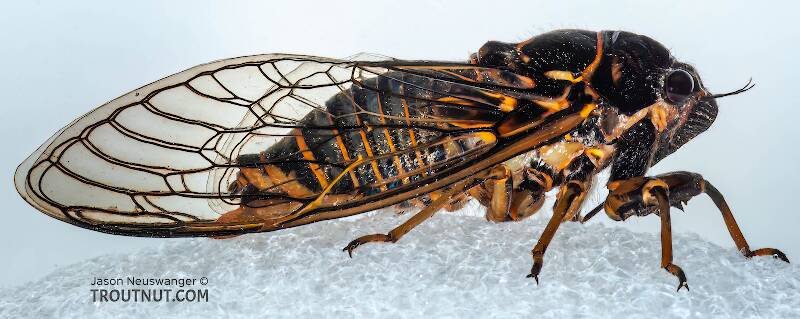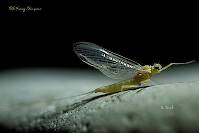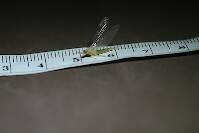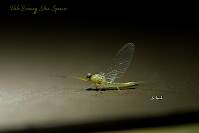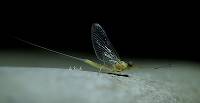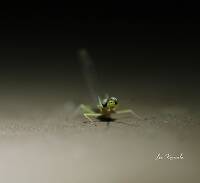
Hex Mayflies
Hexagenia limbata
The famous nocturnal Hex hatch of the Midwest (and a few other lucky locations) stirs to the surface mythically large brown trout that only touch streamers for the rest of the year.
Featured on the forum

This one seems to lead to Couplet 35 of the Key to Genera of Perlodidae Nymphs and the genus Isoperla, but I'm skeptical that's correct based on the general look. I need to get it under the microscope to review several choices in the key, and it'll probably end up a different Perlodidae.

Troutnut is a project started in 2003 by salmonid ecologist Jason "Troutnut" Neuswanger to help anglers and
fly tyers unabashedly embrace the entomological side of the sport. Learn more about Troutnut or
support the project for an enhanced experience here.
This topic is about the True Bug Family Cicadidae
Though they aren't aquatic, cicadas can end up on the surface of trout streams in great numbers in the rare years when they swarm our forests by the tens of millions. It stands to reason that trout would gorge themselves on cicadas at such times, and I have heard reports of it but never been lucky enough to witness the "cicada hatch" myself.Example specimen
JANNEY
Posts: 1
Posts: 1
JANNEY on Jan 4, 2007January 4th, 2007, 12:36 pm EST
My brother and I have a disagreement about bugs from our childhood.
I remember a swarm of cicadas (17-year locusts), and I'm trying to place the year. It would be 1954 to 1959, I believe. I remember the cicadas' distinctive call ringing through the summer (spring?) night. They covered anything that shed light—lampposts, storefront windows, porch lights. They were about in huge numbers. When you walked down the street, you couldn't avoid stepping on them, and they crunched. (Big bugs.)
My brother says he only recalls a mayfly swarm—post 1959—that was so bad it caused auto accidents on the freeway because cars ran over the mayfly bodies and collectively they were greasy and caused cars to skid.
So does anyone out there remember either of these events. I think both probably occurred. We'd like to pin down the years.
Janney
I remember a swarm of cicadas (17-year locusts), and I'm trying to place the year. It would be 1954 to 1959, I believe. I remember the cicadas' distinctive call ringing through the summer (spring?) night. They covered anything that shed light—lampposts, storefront windows, porch lights. They were about in huge numbers. When you walked down the street, you couldn't avoid stepping on them, and they crunched. (Big bugs.)
My brother says he only recalls a mayfly swarm—post 1959—that was so bad it caused auto accidents on the freeway because cars ran over the mayfly bodies and collectively they were greasy and caused cars to skid.
So does anyone out there remember either of these events. I think both probably occurred. We'd like to pin down the years.
Janney
Troutnut on Jan 4, 2007January 4th, 2007, 3:02 pm EST
I'm way too young to remember any of that (heck, so are my parents) but if they really crunched when you walked they were probably cicadas. You could get a little crunch out of a big mayfly but they're long and thin with soft bodies, so they aren't nearly as crunchy as the rotund cicadas.
Where were you, and how close to the nearest river or lake? Location is a big factor for both mayflies and cicadas.
Where were you, and how close to the nearest river or lake? Location is a big factor for both mayflies and cicadas.
Jason Neuswanger, Ph.D.
Troutnut and salmonid ecologist
Troutnut and salmonid ecologist
Brett on Jan 5, 2007January 5th, 2007, 6:38 am EST
The periodic cicada has many different batches and broods...and they are often a local phenomena. Within a state one brood may have a large "hatch" in one region and another have a large hatch just a few years later in another region. I agree with Troutnut that nearby water is often a factor in many insect hacthes. Periodic cicadas would most likely be tracked fairly well by the closest agricultural extension office to the town where you remember the bugs. They would know the most about that particular batch and brood. They can usually be located through the county extension office of the dept. of agriculture. I hope that helps.
Brett
Novice entomologist, fly-tyer and photographer
Novice entomologist, fly-tyer and photographer
CaseyP on Jan 6, 2007January 6th, 2007, 5:13 am EST
Janney,
not sure of where you're remembering, but here in the Washington, D. C., area, i can attest to a big hatch in 2004, as well as one in 1970. there must have been one in 1987 as well, but we weren't here for it. count backwards and there would have been a hatch in 1953.
in 2004, the hatch we witnessed reached from Washington to Fulton County, PA. (it may have gone further than that, but we didn't see it.) so if you're within about a two hour drive of our nation's capital, 1953 could have been your year.
"You can observe a lot by watching." Yogi Berra
GONZO on Jan 6, 2007January 6th, 2007, 5:49 am EST
Janney,
Both Brett and Casey have it right. Periodical cicadas come in 17-year and 13-year varieties. These amazing insects are found in the eastern US and nowhere else. The 17- and 13-year varieties overlap, but the 17-year is more northern in distribution and the 13-year is more southern. (Here in PA, we have the 17-year.)
As Brett says, there are numerous "broods" of both varieties. Some of these broods are small and some are large. Different broods are labeled with roman numerals. The brood that Casey is referring to is brood "X" (also known as the "great eastern brood"). I can remember the emergence of this brood in 2004, 1987, and 1970. I don't remember the prior emergence in 1953 (that was two years before my own "emergence"), but it is a likely candidate for the event you remember. Another possibility would be the emergence of brood "XIV," which last appeared in 1991, and would have appeared in 1957.
The "distinctive call ringing through the summer (spring?) night" was the song of the males, and you probably heard it sometime in late May or June. The call is indeed distinctive to the particular species. Remarkably, after spending 17 years underground, the entire brood often emerges within a matter of hours (or, at most, a few days).
As for the mayfly event that caused the roadways to become slick, this is not that unusual and is much harder to try to pin down. You must be near a large river or a very large lake. From time to time, the bridges in Wilkes Barre have to be closed during the emergence of the white fly (Ephoron spp.) on the Susquehanna due to the smashed bodies of the mayflies causing a slippery situation. I have heard of green drake (Ephemera guttulata) emergences on the upper Delaware causing similar driving hazards, and towns along the Great Lakes or some of the Finger Lakes have experienced such problems during peak emergences of Hexagenia limbata and rigida.
Both Brett and Casey have it right. Periodical cicadas come in 17-year and 13-year varieties. These amazing insects are found in the eastern US and nowhere else. The 17- and 13-year varieties overlap, but the 17-year is more northern in distribution and the 13-year is more southern. (Here in PA, we have the 17-year.)
As Brett says, there are numerous "broods" of both varieties. Some of these broods are small and some are large. Different broods are labeled with roman numerals. The brood that Casey is referring to is brood "X" (also known as the "great eastern brood"). I can remember the emergence of this brood in 2004, 1987, and 1970. I don't remember the prior emergence in 1953 (that was two years before my own "emergence"), but it is a likely candidate for the event you remember. Another possibility would be the emergence of brood "XIV," which last appeared in 1991, and would have appeared in 1957.
The "distinctive call ringing through the summer (spring?) night" was the song of the males, and you probably heard it sometime in late May or June. The call is indeed distinctive to the particular species. Remarkably, after spending 17 years underground, the entire brood often emerges within a matter of hours (or, at most, a few days).
As for the mayfly event that caused the roadways to become slick, this is not that unusual and is much harder to try to pin down. You must be near a large river or a very large lake. From time to time, the bridges in Wilkes Barre have to be closed during the emergence of the white fly (Ephoron spp.) on the Susquehanna due to the smashed bodies of the mayflies causing a slippery situation. I have heard of green drake (Ephemera guttulata) emergences on the upper Delaware causing similar driving hazards, and towns along the Great Lakes or some of the Finger Lakes have experienced such problems during peak emergences of Hexagenia limbata and rigida.
Flags on Feb 3, 2007February 3rd, 2007, 1:01 pm EST
Your post brings back memories...........
Having been born in Erie,PA ( 1945 )and living just a few blocks ( maybe a mile ) from the lakeshore I can vividly remember the mayfly swarms on the streets, lighted storefront windows, and the streetlights. The swarms did indeed cause slippery walking and driving.
The local nickname was "Canadian Sailor" as they usually 'sailed' inland from Lake Erie being pushed by a Northwest, North, or a Northeast wind ( hence, coming from Canada). The nymphs were the primary foodsource for the bluepike fry but alas, with the phosphates and other pollution ( Hammermill ie: International Paper effluent ) that heightened in the 1950s the mayfly population all but disappeared from the bluepke breeding and nursery waters. The blue pike finally died out and as far as anyone knows is now extinct.
The mayflies are making a comeback in recent years which can be attributed to the cleansing of Lake Erie waters but the bluepike are gone.
An interesting recent Doppler radar viewing shows a cloud of mayflies just off the southern shore of Lake Erie. This can be accessed by going to the Pa Aquatic insects web page of Penn State and clicking on the Mayfly icon.
Regards,
Flags
Having been born in Erie,PA ( 1945 )and living just a few blocks ( maybe a mile ) from the lakeshore I can vividly remember the mayfly swarms on the streets, lighted storefront windows, and the streetlights. The swarms did indeed cause slippery walking and driving.
The local nickname was "Canadian Sailor" as they usually 'sailed' inland from Lake Erie being pushed by a Northwest, North, or a Northeast wind ( hence, coming from Canada). The nymphs were the primary foodsource for the bluepike fry but alas, with the phosphates and other pollution ( Hammermill ie: International Paper effluent ) that heightened in the 1950s the mayfly population all but disappeared from the bluepke breeding and nursery waters. The blue pike finally died out and as far as anyone knows is now extinct.
The mayflies are making a comeback in recent years which can be attributed to the cleansing of Lake Erie waters but the bluepike are gone.
An interesting recent Doppler radar viewing shows a cloud of mayflies just off the southern shore of Lake Erie. This can be accessed by going to the Pa Aquatic insects web page of Penn State and clicking on the Mayfly icon.
Regards,
Flags
Stay focused on what is important in life...........
Konchu on Feb 7, 2007February 7th, 2007, 8:28 am EST
A couple years ago my wife and I went to the annual "Fishfly" [=burrowing mayfly] Festival in New Baltimore, Michigan off Lake St. Clair (?). The festival doesn't exactly celebrate the massive hatch, but instead, it is more tongue-in-cheek, celebrating the festival continuing IN SPITE of the flies. Intersections were slick with bug guts, and in years past, gears on the amusements had to be cleaned out between rides.
Quick Reply
Related Discussions
Topic
Replies
Last Reply
1
Aug 21, 2007
by Gene
by Gene
5
Sep 10, 2020
by Leskorcala
by Leskorcala
I agree with the nymph and emergence coments above
In the Mayfly Species Litobrancha recurvata by Beardius
In the Mayfly Species Litobrancha recurvata by Beardius
0
Aug 1, 2008
by Beardius
by Beardius
5
Dec 4, 2008
by Beardius
by Beardius


